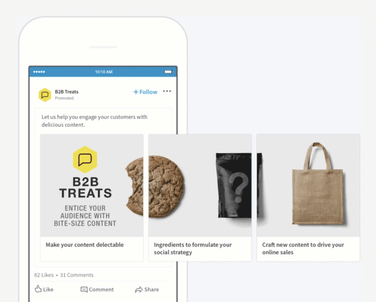
Creating ads for B2B companies can be a challenge in any platform, but LinkedIn has continued to show a lot of promise in the B2B space. If you’re not already building ads on LinkedIn, then you should start today.
Why? LinkedIn boasts over 580 million users and is the world’s largest professional community. While your target audience may have different buying behaviors and demographics, there’s a high probability they’re part of this community.
Setting up an ad campaign on LinkedIn isn’t difficult, but I want to share five tips based on the lessons I’ve learned from building countless campaigns for our clients. Hopefully, this will give you a head start over the competition.
Hack 1: Which Ad Format Performs Best?
LinkedIn has three primary ad formats: Sponsored Content, Sponsored InMail, and Text Ads. Personally, I think Text Ads are boring. I rarely recommend them since they’re known for their low click-through -rates (CTR), plus they only work on desktop.
The only upside to Text Ads is that they’re low risk with a lower cost-per-click (CPC). If you want to do something low risk, like testing your ad copy, this may be an option.
That leaves us with Sponsored Content and Sponsored InMail. The majority of your campaigns should be Sponsored Content. Sponsored InMail has a place, but it’s the most challenging to nail. When selecting what format to use, your goals will play a large role in deciding which will perform best.
To help you out, here are my suggestions depending on your objectives:
Brand Awareness:  Carousel Ads and Video Ads are the best formats to use for brand awareness because they give you more time on an ad than any other format. The key is to find a compelling story to tell, then choose the best format for your story. If you decide on a video, for example, make sure to include subtitles.
Carousel Ads and Video Ads are the best formats to use for brand awareness because they give you more time on an ad than any other format. The key is to find a compelling story to tell, then choose the best format for your story. If you decide on a video, for example, make sure to include subtitles.
Lead Generation:
A single Image Ad with a Lead Gen Form is the best ad format for lead generation.
Hack 2: How Should I Structure My Campaigns?
Many B2B marketers overlook the structure of their campaigns, but there are a few key tips that can really help you keep your campaigns organized and clean.
Tip 1: Campaign Naming
If you already have a nomenclature, then great, use it. If you don’t have one, then make one and be consistent. The main elements of the naming convention should tell you what it is, who it’s for, and where it’s showing geographically.
Tip 2: Micro-Segmentation
This is where campaigns usually fail. Don’t lump all segments into one campaign group. Instead, separate them. For example:
- BAD: One campaign group — segment by job titles “Marketing Manager,” “VP of marketing,”“CEO”
- GOOD: Three segmented campaign groups under one campaign — Campaign Group 1 — job title “marketing manager,” Campaign Group 2 — job title “VP of marketing,” Campaign Group 3 — job title “CEO”
Micro-segmenting allows you to hyper-personalize your ads to the persona you’re targeting. The more personalized you can be, the better your conversion rates will be. Dynamic Ads, however, are the exception to this rule. They’re garbage, so don’t use them.
Tip 3: Audience Size
LinkedIn recommends that you aim for 300k in your audience size, but this is too big. Try to narrow your audience size to 20 to 80k. Why? It increases your lead quality, boosting your results.
Hack 3: What Content Should I Offer?
If your ad goal is brand awareness, then your content focus should be on your ad copy to drive traffic to your website. The story you tell needs to be engaging and rooted in the value your solution provides to make your brand awareness campaign successful.
However, if your focus is lead generation, then you have to find the sweet spot. This can vary by target audience, but it generally lives somewhere among guides, white papers, eBooks, and webinars. Basically, anything you can put behind a form to collect leads.
The key here is that your content needs to be something people are willing to give up their email address to read without causing a lot of friction. Depending on the ask, the level of friction will either be higher or lower.
For example, a blog post or ungated content is low friction. A demo request is a high friction ask, and LinkedIn usually is not a good place for it. So, be mindful of the buyer’s journey when setting up your lead generation campaign to ensure the best possible lead quality.
If someone is at the end of their buying journey, then you’re better off using retargeting. Ideally, you should already have their info and have them in a drip campaign for further nurturing.
Check out this video to learn more on decreasing friction:
Hack 4: How Can I Be Better at Targeting?
We can all be better at targeting. What I find helpful is whiteboarding as many details about a target audience as possible. Hopefully, you have some buyer personas to help you out. If not, use our free template.
With buyer personas in hand, it’s time to think about exclusions. Exclusions help you be more targeted in your approach and ensure you’re targeting the people you want to reach, increasing the quality of your leads.
As you set up your campaign, these are some common exclusions to use for optimal success: “Job Title” is the most competitive and precise, but also the most expensive
- “Job Title” —the most competitive and precise, but also the most expensive
- “Job Function” — very broad, but the least expensive
- “Skills” or “Groups” — excludes sales and marketing job functions
- “Small and Medium Business (SMB)” —excludes larger companies
- “Seniority” — excludes junior executives more reliably than either “age” or “experience”
- “Disable Audience Expansion” — muddies up leads with junk and should be avoided

Hack 5: Where Should I Optimize My Current LinkedIn Strategy?
Once you start your campaign and let it run for a bit (two weeks minimum), you’ll need to consider optimization. There are three reporting metrics you need to look at: impressions, clicks, and CTR.
Based on these readings, here is what you’ll want to change:
- High Impressions, Low Clicks: Change out the offer title and imagery. This might require a few iterations before you find something that works.
- High Clicks, Low CTR: Change the landing page you’re taking them to. (If you’re using Lead Gen Forms, then this won’t apply.) A few best practices for your landing page include making sure there is only one offer and focus for the page, removing the navigation to keep them from going to another page, and breaking up your text by using bullet points to get your main points across. Lastly, limit the number of fields someone has to fill out on your form. Stick to no more than four. If you can get away with just getting an email, then do that.
- Bonus Optimization: Aim for marketing and sales alignment. Go to your sales team and educate them on what you’re doing over in marketing. That alignment is crucial for passing off leads. You can read more about sales and marketing alignment here.
LinkedIn outperforms all other ad platforms for our B2B agency. It’s why I strongly recommend them to every client we onboard. While following these tips doesn’t guarantee instant success, the results are well worth the effort.
To hit it out of the park with your LinkedIn campaigns, it’s important to put in the headwork before the footwork. It is also crucial to know your target audience and to build out your buyer personas. Doing so will help you better understand who they are, their interests, and, most importantly, where to target them online.
Want more advice?
Reach out to us and get started building your LinkedIn campaigns.





